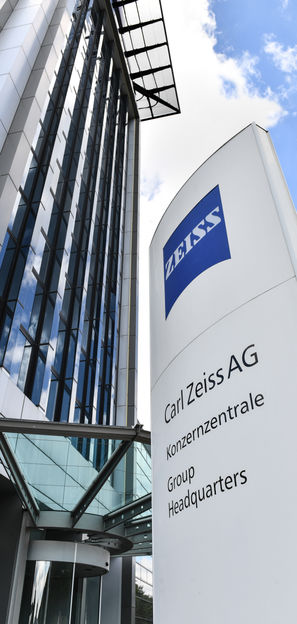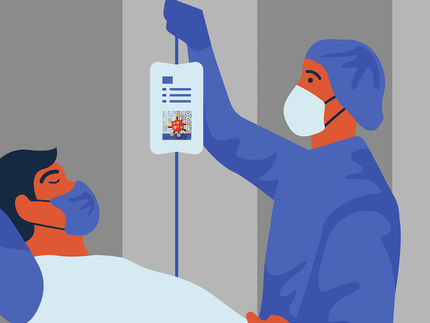ZEISS Reports Successful Start to Fiscal Year
ZEISS Group successfully navigates pandemic thanks to broad portfolio and global structure
The ZEISS Group had a successful end to the first six months of fiscal year 2020/21 (ended 31 March 2021). It saw its revenue rise by 6 percent (adjusted for currency fluctuations, by 9 percent) to 3.406 billion euros (previous year: 3.213 billion euros). Around 90% of this sum was generated in markets outside Germany. At 591 million euros, earnings before interest and tax (EBIT) were significantly higher than in the previous year (455 million euros). The EBIT margin was 17%. Incoming orders increased to 4.200 billion euros (prior year: 3.601 billion euros).

ZEISS Group's headquarters
Photo: ZEISS
"Thanks to our broad portfolio, global structure and the exceptional dedication of our employees, we have successfully navigated through the COVID-19 pandemic," said Dr. Karl Lamprecht, ZEISS President and CEO. "This has allowed us to get off to a good start in the first half of the new fiscal year. Our global investment strategy and high expenditure on research and development over many years are now paying off. We will be continuing to make these investments."
In general, business at ZEISS' four segments has developed well over the past fiscal year.
ZEISS is continuing to see growth in the semiconductor market. The Semiconductor Manufacturing Technology segment has been able to expand its high revenue in the current fiscal year compared to the disproportionately strong equivalent period in the previous year. Due to the high demand for the innovative extreme ultraviolet (EUV) lithography systems and deep ultraviolet (DUV) lithography systems, ZEISS has every reason to be optimistic about the second half of the year. Global trends such as 5G, artificial intelligence, the Internet of Things and high-performance computing solutions, are the major drivers fueling this high demand.
The Industrial Quality & Research segment reported stable development for the first six months of this fiscal year: the industrial metrology business is slowly recovering from the impact of the COVID-19 pandemic. The general structural and technology transformation continues to pose a challenge, particularly in the automobile industry. Adjusted for currency fluctuations, the microscopy solutions business achieved two-digit growth. Growth opportunities for both business areas at the segment come in the form of e-mobility: microscopy and quality assurance solutions are deployed in battery research and in quality assurance for battery production.
In the first six months of the year, the Medical Technology segment achieved clear revenue growth once again. The impact of the COVID-19 pandemic is ebbing away, allowing the segment to boost its growth rate back up to its pre-pandemic level. Major contributions to growth came from returning revenues from consumables, implants and services rendered. Meanwhile, sales and marketing costs were comparatively low given the continued limitations imposed by the pandemic.
The Consumer Markets segment has certainly recovered from the impact of the COVID-19 pandemic, concluding the first six months of the year with a very good revenue, and earning market shares as well. Despite further regional lockdown-induced limitations in the eyeglass lens market, the outlook for the second half of the fiscal year remains positive. The pandemic has meant that the conditions for logistics and delivery reliability will remain challenging.
Key figures
Free cash flow amounted to 609 million euros (first six months of 2019/20: 180 million euros). The company's equity rose by 13 percent as compared to fiscal year 2019/20, totaling 4,840 million euros (30 September 2020: 4,287 million euros).
ZEISS' expenditure on research and development totaled around 12 percent of revenue in the first half of fiscal year 2020/21. This amounted to 425 million euros of revenue (first six months of 2019/20: 398 million euros),
Investments in property, plant and equipment amounted to 264 million euros in the reporting period (first six months of 2019/20: 215 million euros), as compared to depreciations totaling EUR 127 million (first six months of 2019/20: 123 million euros).
At the end of the reporting period on 31 March 2021, net liquidity totaled 1,829 million euros.
In the Americas and APAC regions, distinct revenue growth has been achieved, adjusted for currency fluctuations. Slight growth was also reported in the EMEA region.
"Growth at the ZEISS Group is based on forward-looking decisions and a little patience, " says Dr. Christian Müller, Chief Financial Officer of Carl Zeiss AG. "While our sizeable investments in research and development do not always immediately pay off, a little patience coupled with innovative ideas allow us to shape the market. ZEISS' investment strategy, i.e. investments in technology, infrastructure and our strategic presence in the world's high-tech hubs, also includes the ZEISS Innovation Center that was opened this year in Dublin, California. This allows us to bolster the links between science and business, thus opening up new marketing opportunities in the digital arena."
ZEISS does not shy away from its responsibility toward ensuring sustainability. "Our goal is to embed sustainability throughout the company, rendering it measurable and developing it further," says Müller. "ZEISS aims to operate in a carbon-neutral way in its own activities worldwide by 2025. This supplements the company's existing goal of switching to green power by 2022."
ZEISS' new partnerships and acquisitions in the first half of the fiscal year include the partnership with global technology player vivo in the area of mobile imaging, which was announced in December. As part of this strategic collaboration, the two companies are working on projects such as developing imaging systems for vivo's smartphones. Furthermore, in order to expand its offering in microscopy with innovative 3D and big data software solutions, back in December ZEISS acquired a majority stake in arivis AG. This is how the company is bolstering its software skills and market position in the field of 3D visualization and analysis technology.
At the end of the first six months of the current fiscal year (31 March 2021), ZEISS had a global workforce of 34,434 employees. Its headcount thus increased by more than 8% as compared to 31 March 2020. This also reflects the segments' growth trajectory. For instance, in the first half of the fiscal year the Semiconductor Manufacturing Technology segment hired over 450 new people. And 300 further new positions will help the segment to continue growing in the second half of the fiscal year.
Outlook
Moreover, the global economy will face considerable challenges due to the COVID-19 pandemic. However, the current economic trends offer a positive outlook. ZEISS therefore expects to see a rise in revenue for fiscal year 2020/21. "While the impact of the global pandemic does raise some doubts, we remain optimistic as regards the second half of the fiscal year," says Lamprecht.
2021 is also a special year for ZEISS, as it will be celebrating its 175th anniversary, to honor the day in November 1846 when Carl Zeiss established the company in Jena.























































